Cardiovascular Diseases: Evolocumab Therapy Efficacy and Cost Analysis
VerifiedAdded on 2023/06/05
|13
|2881
|331
Report
AI Summary
This report provides a comprehensive analysis of cardiovascular diseases, focusing on the efficacy and cost-effectiveness of Evolocumab therapy. The report begins with a PICO framework, defining the population, intervention, comparison, outcome, and timeframe for the research question. It then examines the research question: "Does administration of the Evolocumab Therapy reduce the frequency and probability of cardiovascular events among the cardiovascular patients in comparison to patient with no usage of Evolocumab Therapy within the timeframe of 1 year approximately?" The report evaluates several research articles, including studies by Sabatine et al. (2015, 2017), Nicholls et al. (2016), and Fonarow et al. (2017), which explore the impact of Evolocumab on LDL cholesterol levels, cardiovascular events, and cost-effectiveness. The literature review highlights the therapy's effectiveness in reducing LDL cholesterol and the incidence of cardiovascular events when combined with standard treatments. The report also addresses the cost-effectiveness of Evolocumab and recommends further research, including pilot randomized control studies to assess the therapy's effectiveness independently. The report underscores the relevance of cardiovascular disease as a significant health issue, particularly in Australia, and emphasizes the potential of Evolocumab therapy to improve patient outcomes and reduce mortality rates.
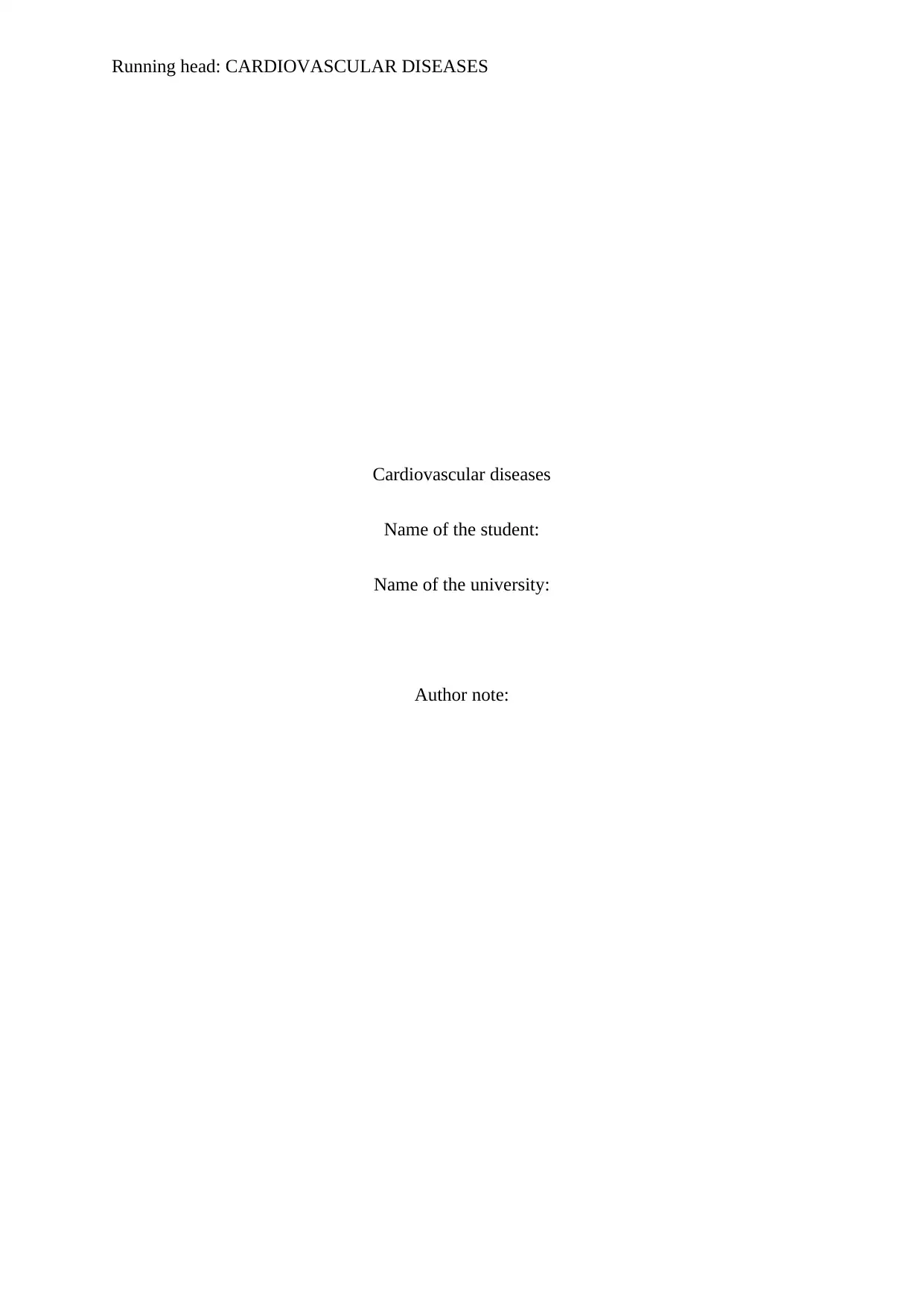
Running head: CARDIOVASCULAR DISEASES
Cardiovascular diseases
Name of the student:
Name of the university:
Author note:
Cardiovascular diseases
Name of the student:
Name of the university:
Author note:
Paraphrase This Document
Need a fresh take? Get an instant paraphrase of this document with our AI Paraphraser
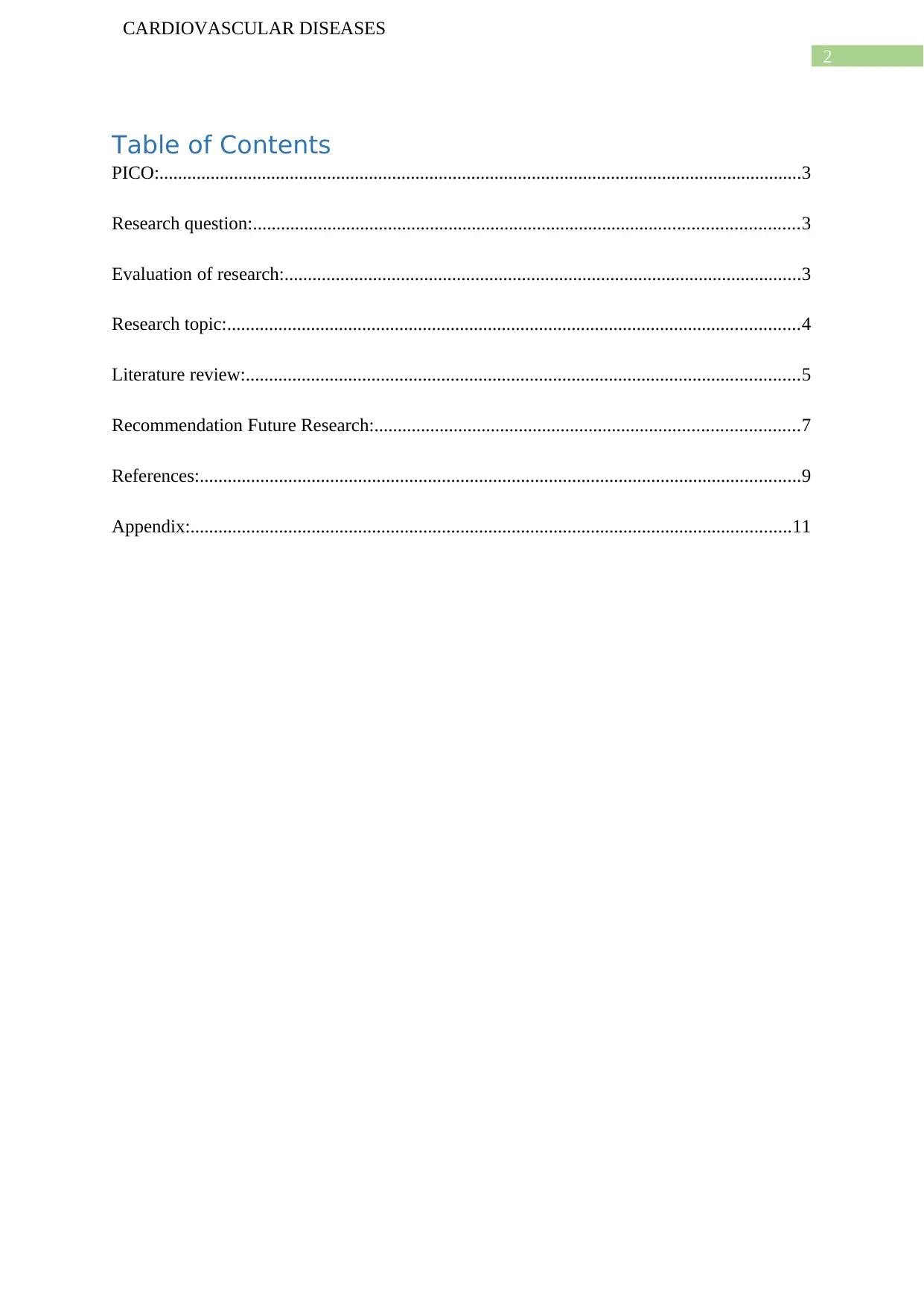
2
CARDIOVASCULAR DISEASES
Table of Contents
PICO:..........................................................................................................................................3
Research question:.....................................................................................................................3
Evaluation of research:...............................................................................................................3
Research topic:...........................................................................................................................4
Literature review:.......................................................................................................................5
Recommendation Future Research:...........................................................................................7
References:.................................................................................................................................9
Appendix:.................................................................................................................................11
CARDIOVASCULAR DISEASES
Table of Contents
PICO:..........................................................................................................................................3
Research question:.....................................................................................................................3
Evaluation of research:...............................................................................................................3
Research topic:...........................................................................................................................4
Literature review:.......................................................................................................................5
Recommendation Future Research:...........................................................................................7
References:.................................................................................................................................9
Appendix:.................................................................................................................................11
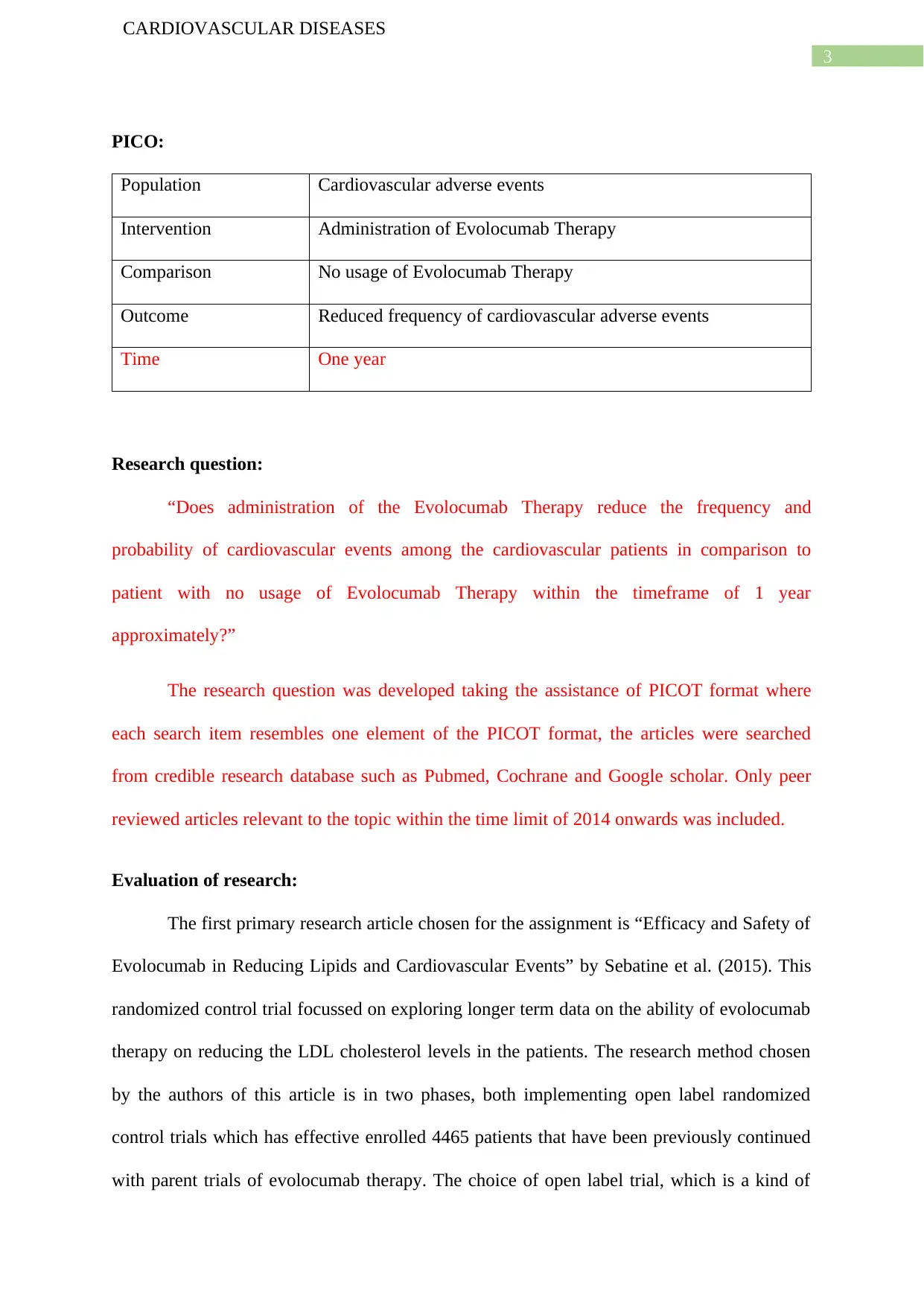
3
CARDIOVASCULAR DISEASES
PICO:
Population Cardiovascular adverse events
Intervention Administration of Evolocumab Therapy
Comparison No usage of Evolocumab Therapy
Outcome Reduced frequency of cardiovascular adverse events
Time One year
Research question:
“Does administration of the Evolocumab Therapy reduce the frequency and
probability of cardiovascular events among the cardiovascular patients in comparison to
patient with no usage of Evolocumab Therapy within the timeframe of 1 year
approximately?”
The research question was developed taking the assistance of PICOT format where
each search item resembles one element of the PICOT format, the articles were searched
from credible research database such as Pubmed, Cochrane and Google scholar. Only peer
reviewed articles relevant to the topic within the time limit of 2014 onwards was included.
Evaluation of research:
The first primary research article chosen for the assignment is “Efficacy and Safety of
Evolocumab in Reducing Lipids and Cardiovascular Events” by Sebatine et al. (2015). This
randomized control trial focussed on exploring longer term data on the ability of evolocumab
therapy on reducing the LDL cholesterol levels in the patients. The research method chosen
by the authors of this article is in two phases, both implementing open label randomized
control trials which has effective enrolled 4465 patients that have been previously continued
with parent trials of evolocumab therapy. The choice of open label trial, which is a kind of
CARDIOVASCULAR DISEASES
PICO:
Population Cardiovascular adverse events
Intervention Administration of Evolocumab Therapy
Comparison No usage of Evolocumab Therapy
Outcome Reduced frequency of cardiovascular adverse events
Time One year
Research question:
“Does administration of the Evolocumab Therapy reduce the frequency and
probability of cardiovascular events among the cardiovascular patients in comparison to
patient with no usage of Evolocumab Therapy within the timeframe of 1 year
approximately?”
The research question was developed taking the assistance of PICOT format where
each search item resembles one element of the PICOT format, the articles were searched
from credible research database such as Pubmed, Cochrane and Google scholar. Only peer
reviewed articles relevant to the topic within the time limit of 2014 onwards was included.
Evaluation of research:
The first primary research article chosen for the assignment is “Efficacy and Safety of
Evolocumab in Reducing Lipids and Cardiovascular Events” by Sebatine et al. (2015). This
randomized control trial focussed on exploring longer term data on the ability of evolocumab
therapy on reducing the LDL cholesterol levels in the patients. The research method chosen
by the authors of this article is in two phases, both implementing open label randomized
control trials which has effective enrolled 4465 patients that have been previously continued
with parent trials of evolocumab therapy. The choice of open label trial, which is a kind of
⊘ This is a preview!⊘
Do you want full access?
Subscribe today to unlock all pages.

Trusted by 1+ million students worldwide
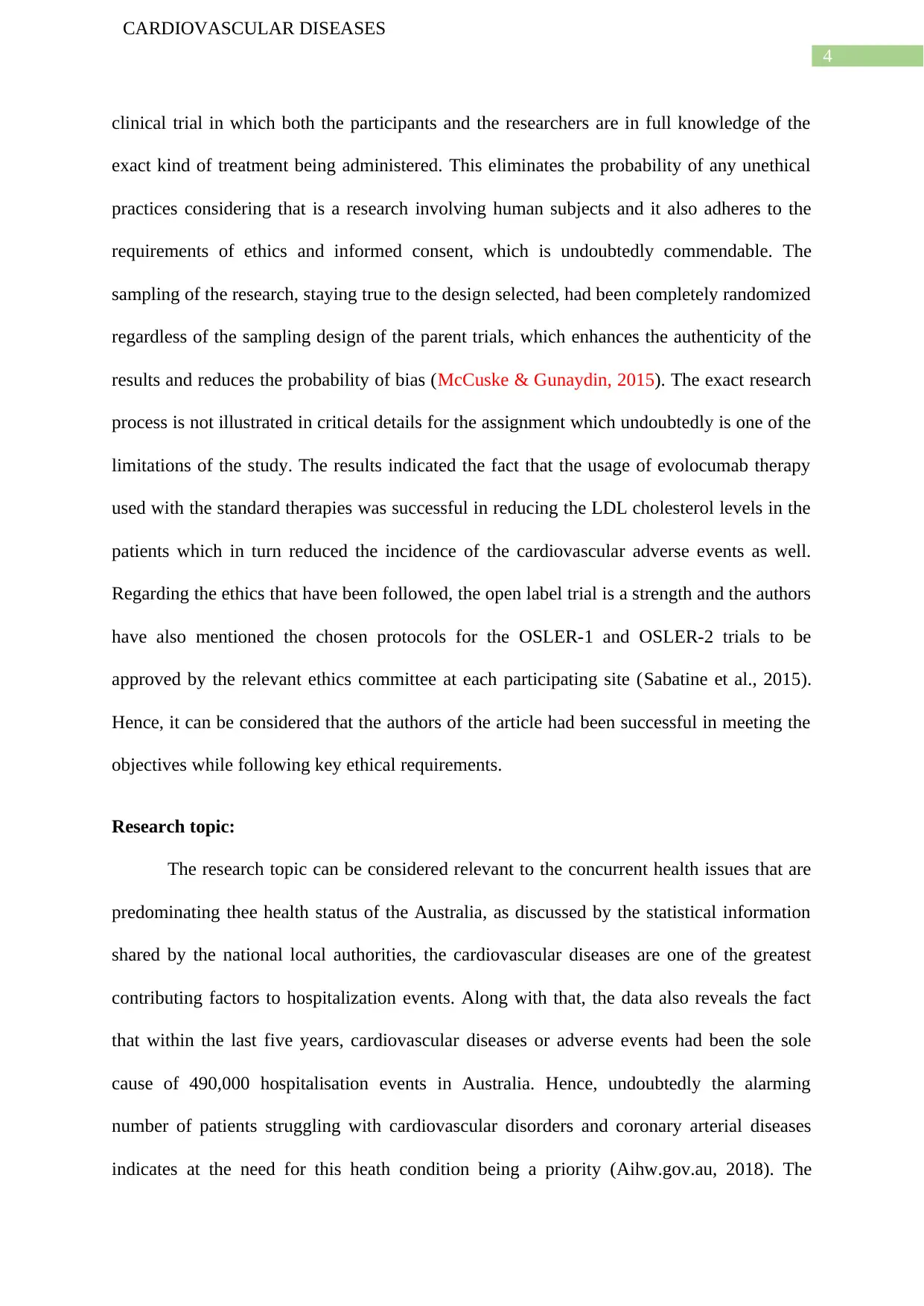
4
CARDIOVASCULAR DISEASES
clinical trial in which both the participants and the researchers are in full knowledge of the
exact kind of treatment being administered. This eliminates the probability of any unethical
practices considering that is a research involving human subjects and it also adheres to the
requirements of ethics and informed consent, which is undoubtedly commendable. The
sampling of the research, staying true to the design selected, had been completely randomized
regardless of the sampling design of the parent trials, which enhances the authenticity of the
results and reduces the probability of bias (McCuske & Gunaydin, 2015). The exact research
process is not illustrated in critical details for the assignment which undoubtedly is one of the
limitations of the study. The results indicated the fact that the usage of evolocumab therapy
used with the standard therapies was successful in reducing the LDL cholesterol levels in the
patients which in turn reduced the incidence of the cardiovascular adverse events as well.
Regarding the ethics that have been followed, the open label trial is a strength and the authors
have also mentioned the chosen protocols for the OSLER-1 and OSLER-2 trials to be
approved by the relevant ethics committee at each participating site (Sabatine et al., 2015).
Hence, it can be considered that the authors of the article had been successful in meeting the
objectives while following key ethical requirements.
Research topic:
The research topic can be considered relevant to the concurrent health issues that are
predominating thee health status of the Australia, as discussed by the statistical information
shared by the national local authorities, the cardiovascular diseases are one of the greatest
contributing factors to hospitalization events. Along with that, the data also reveals the fact
that within the last five years, cardiovascular diseases or adverse events had been the sole
cause of 490,000 hospitalisation events in Australia. Hence, undoubtedly the alarming
number of patients struggling with cardiovascular disorders and coronary arterial diseases
indicates at the need for this heath condition being a priority (Aihw.gov.au, 2018). The
CARDIOVASCULAR DISEASES
clinical trial in which both the participants and the researchers are in full knowledge of the
exact kind of treatment being administered. This eliminates the probability of any unethical
practices considering that is a research involving human subjects and it also adheres to the
requirements of ethics and informed consent, which is undoubtedly commendable. The
sampling of the research, staying true to the design selected, had been completely randomized
regardless of the sampling design of the parent trials, which enhances the authenticity of the
results and reduces the probability of bias (McCuske & Gunaydin, 2015). The exact research
process is not illustrated in critical details for the assignment which undoubtedly is one of the
limitations of the study. The results indicated the fact that the usage of evolocumab therapy
used with the standard therapies was successful in reducing the LDL cholesterol levels in the
patients which in turn reduced the incidence of the cardiovascular adverse events as well.
Regarding the ethics that have been followed, the open label trial is a strength and the authors
have also mentioned the chosen protocols for the OSLER-1 and OSLER-2 trials to be
approved by the relevant ethics committee at each participating site (Sabatine et al., 2015).
Hence, it can be considered that the authors of the article had been successful in meeting the
objectives while following key ethical requirements.
Research topic:
The research topic can be considered relevant to the concurrent health issues that are
predominating thee health status of the Australia, as discussed by the statistical information
shared by the national local authorities, the cardiovascular diseases are one of the greatest
contributing factors to hospitalization events. Along with that, the data also reveals the fact
that within the last five years, cardiovascular diseases or adverse events had been the sole
cause of 490,000 hospitalisation events in Australia. Hence, undoubtedly the alarming
number of patients struggling with cardiovascular disorders and coronary arterial diseases
indicates at the need for this heath condition being a priority (Aihw.gov.au, 2018). The
Paraphrase This Document
Need a fresh take? Get an instant paraphrase of this document with our AI Paraphraser
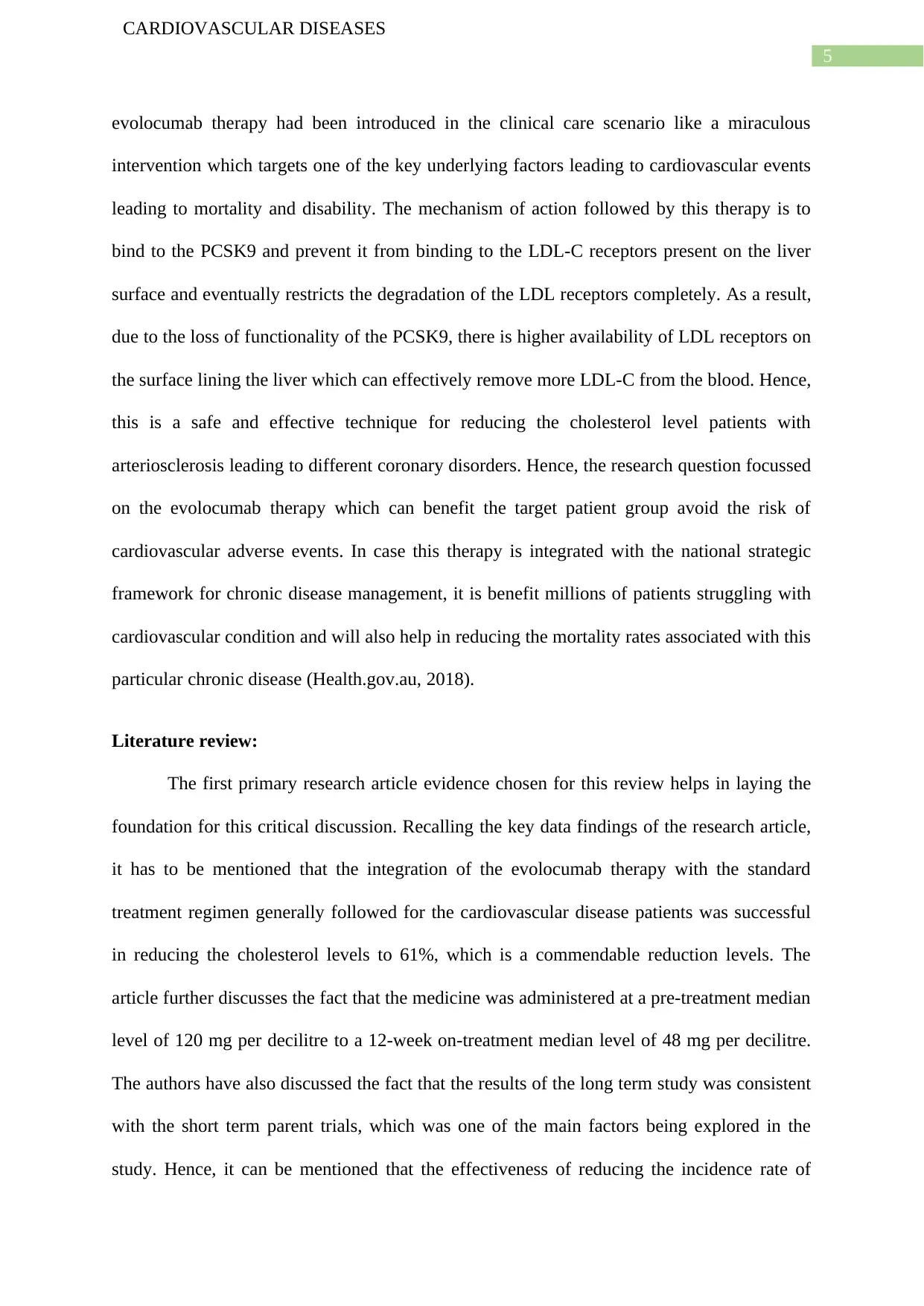
5
CARDIOVASCULAR DISEASES
evolocumab therapy had been introduced in the clinical care scenario like a miraculous
intervention which targets one of the key underlying factors leading to cardiovascular events
leading to mortality and disability. The mechanism of action followed by this therapy is to
bind to the PCSK9 and prevent it from binding to the LDL-C receptors present on the liver
surface and eventually restricts the degradation of the LDL receptors completely. As a result,
due to the loss of functionality of the PCSK9, there is higher availability of LDL receptors on
the surface lining the liver which can effectively remove more LDL-C from the blood. Hence,
this is a safe and effective technique for reducing the cholesterol level patients with
arteriosclerosis leading to different coronary disorders. Hence, the research question focussed
on the evolocumab therapy which can benefit the target patient group avoid the risk of
cardiovascular adverse events. In case this therapy is integrated with the national strategic
framework for chronic disease management, it is benefit millions of patients struggling with
cardiovascular condition and will also help in reducing the mortality rates associated with this
particular chronic disease (Health.gov.au, 2018).
Literature review:
The first primary research article evidence chosen for this review helps in laying the
foundation for this critical discussion. Recalling the key data findings of the research article,
it has to be mentioned that the integration of the evolocumab therapy with the standard
treatment regimen generally followed for the cardiovascular disease patients was successful
in reducing the cholesterol levels to 61%, which is a commendable reduction levels. The
article further discusses the fact that the medicine was administered at a pre-treatment median
level of 120 mg per decilitre to a 12-week on-treatment median level of 48 mg per decilitre.
The authors have also discussed the fact that the results of the long term study was consistent
with the short term parent trials, which was one of the main factors being explored in the
study. Hence, it can be mentioned that the effectiveness of reducing the incidence rate of
CARDIOVASCULAR DISEASES
evolocumab therapy had been introduced in the clinical care scenario like a miraculous
intervention which targets one of the key underlying factors leading to cardiovascular events
leading to mortality and disability. The mechanism of action followed by this therapy is to
bind to the PCSK9 and prevent it from binding to the LDL-C receptors present on the liver
surface and eventually restricts the degradation of the LDL receptors completely. As a result,
due to the loss of functionality of the PCSK9, there is higher availability of LDL receptors on
the surface lining the liver which can effectively remove more LDL-C from the blood. Hence,
this is a safe and effective technique for reducing the cholesterol level patients with
arteriosclerosis leading to different coronary disorders. Hence, the research question focussed
on the evolocumab therapy which can benefit the target patient group avoid the risk of
cardiovascular adverse events. In case this therapy is integrated with the national strategic
framework for chronic disease management, it is benefit millions of patients struggling with
cardiovascular condition and will also help in reducing the mortality rates associated with this
particular chronic disease (Health.gov.au, 2018).
Literature review:
The first primary research article evidence chosen for this review helps in laying the
foundation for this critical discussion. Recalling the key data findings of the research article,
it has to be mentioned that the integration of the evolocumab therapy with the standard
treatment regimen generally followed for the cardiovascular disease patients was successful
in reducing the cholesterol levels to 61%, which is a commendable reduction levels. The
article further discusses the fact that the medicine was administered at a pre-treatment median
level of 120 mg per decilitre to a 12-week on-treatment median level of 48 mg per decilitre.
The authors have also discussed the fact that the results of the long term study was consistent
with the short term parent trials, which was one of the main factors being explored in the
study. Hence, it can be mentioned that the effectiveness of reducing the incidence rate of
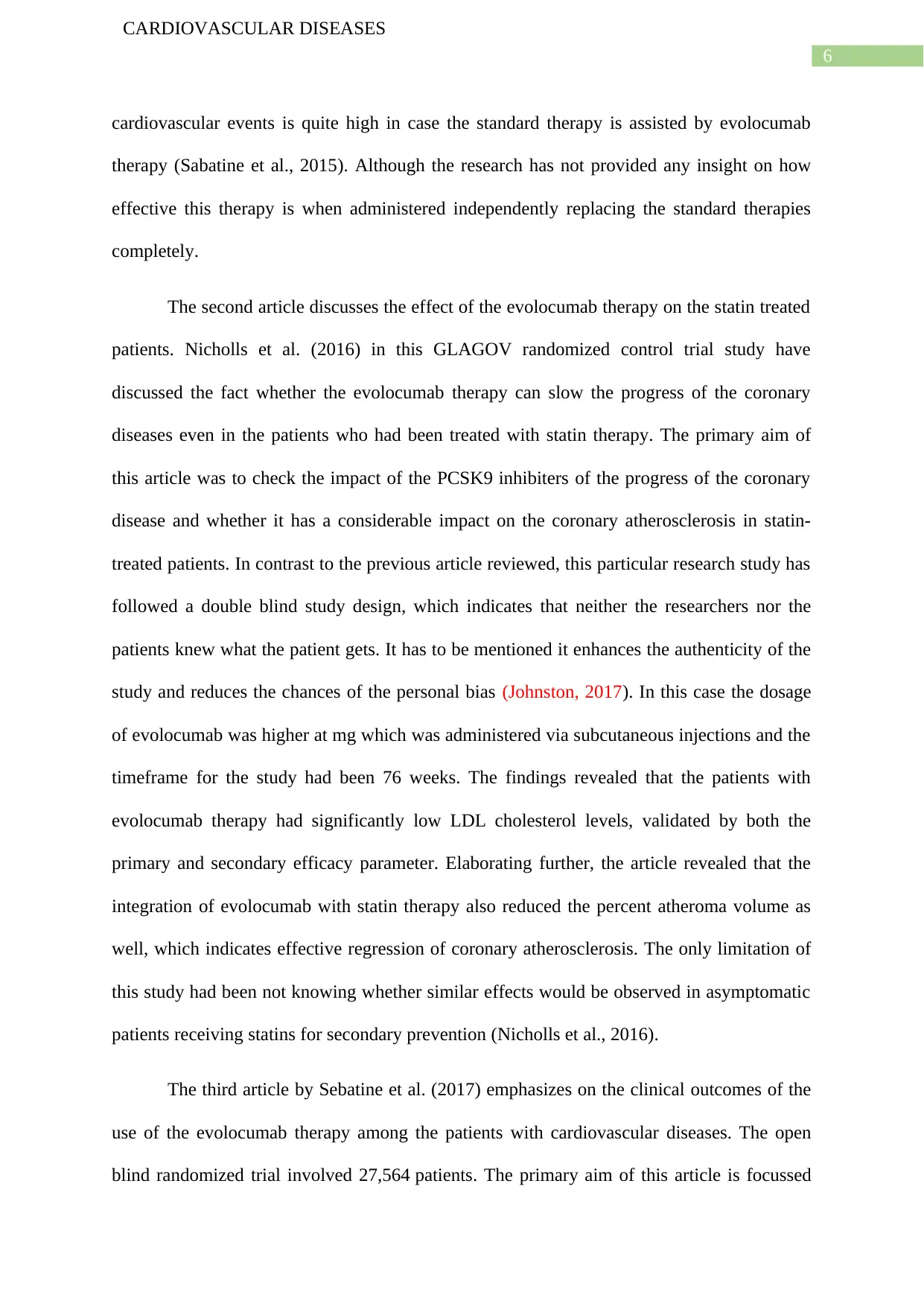
6
CARDIOVASCULAR DISEASES
cardiovascular events is quite high in case the standard therapy is assisted by evolocumab
therapy (Sabatine et al., 2015). Although the research has not provided any insight on how
effective this therapy is when administered independently replacing the standard therapies
completely.
The second article discusses the effect of the evolocumab therapy on the statin treated
patients. Nicholls et al. (2016) in this GLAGOV randomized control trial study have
discussed the fact whether the evolocumab therapy can slow the progress of the coronary
diseases even in the patients who had been treated with statin therapy. The primary aim of
this article was to check the impact of the PCSK9 inhibiters of the progress of the coronary
disease and whether it has a considerable impact on the coronary atherosclerosis in statin-
treated patients. In contrast to the previous article reviewed, this particular research study has
followed a double blind study design, which indicates that neither the researchers nor the
patients knew what the patient gets. It has to be mentioned it enhances the authenticity of the
study and reduces the chances of the personal bias (Johnston, 2017). In this case the dosage
of evolocumab was higher at mg which was administered via subcutaneous injections and the
timeframe for the study had been 76 weeks. The findings revealed that the patients with
evolocumab therapy had significantly low LDL cholesterol levels, validated by both the
primary and secondary efficacy parameter. Elaborating further, the article revealed that the
integration of evolocumab with statin therapy also reduced the percent atheroma volume as
well, which indicates effective regression of coronary atherosclerosis. The only limitation of
this study had been not knowing whether similar effects would be observed in asymptomatic
patients receiving statins for secondary prevention (Nicholls et al., 2016).
The third article by Sebatine et al. (2017) emphasizes on the clinical outcomes of the
use of the evolocumab therapy among the patients with cardiovascular diseases. The open
blind randomized trial involved 27,564 patients. The primary aim of this article is focussed
CARDIOVASCULAR DISEASES
cardiovascular events is quite high in case the standard therapy is assisted by evolocumab
therapy (Sabatine et al., 2015). Although the research has not provided any insight on how
effective this therapy is when administered independently replacing the standard therapies
completely.
The second article discusses the effect of the evolocumab therapy on the statin treated
patients. Nicholls et al. (2016) in this GLAGOV randomized control trial study have
discussed the fact whether the evolocumab therapy can slow the progress of the coronary
diseases even in the patients who had been treated with statin therapy. The primary aim of
this article was to check the impact of the PCSK9 inhibiters of the progress of the coronary
disease and whether it has a considerable impact on the coronary atherosclerosis in statin-
treated patients. In contrast to the previous article reviewed, this particular research study has
followed a double blind study design, which indicates that neither the researchers nor the
patients knew what the patient gets. It has to be mentioned it enhances the authenticity of the
study and reduces the chances of the personal bias (Johnston, 2017). In this case the dosage
of evolocumab was higher at mg which was administered via subcutaneous injections and the
timeframe for the study had been 76 weeks. The findings revealed that the patients with
evolocumab therapy had significantly low LDL cholesterol levels, validated by both the
primary and secondary efficacy parameter. Elaborating further, the article revealed that the
integration of evolocumab with statin therapy also reduced the percent atheroma volume as
well, which indicates effective regression of coronary atherosclerosis. The only limitation of
this study had been not knowing whether similar effects would be observed in asymptomatic
patients receiving statins for secondary prevention (Nicholls et al., 2016).
The third article by Sebatine et al. (2017) emphasizes on the clinical outcomes of the
use of the evolocumab therapy among the patients with cardiovascular diseases. The open
blind randomized trial involved 27,564 patients. The primary aim of this article is focussed
⊘ This is a preview!⊘
Do you want full access?
Subscribe today to unlock all pages.

Trusted by 1+ million students worldwide
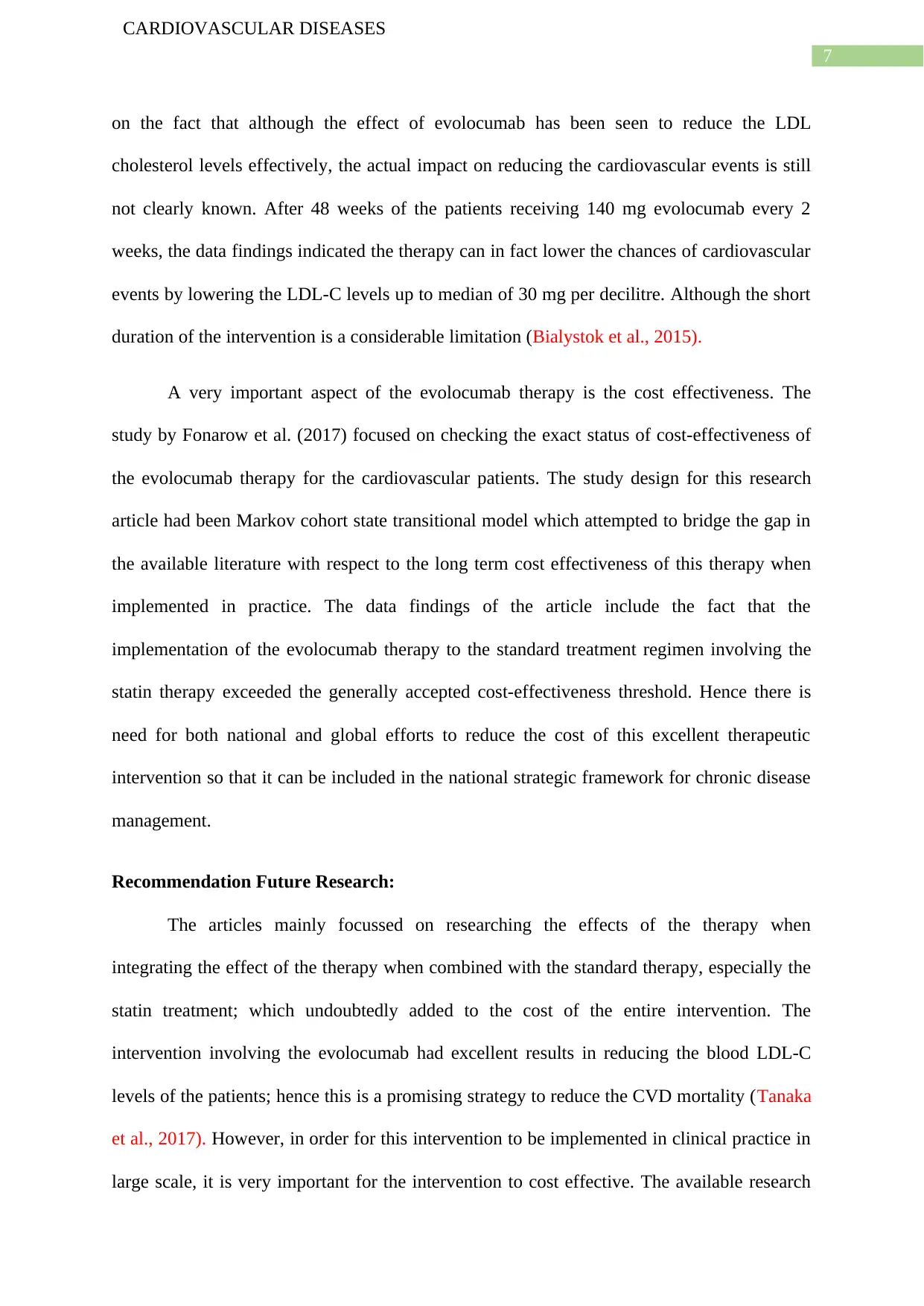
7
CARDIOVASCULAR DISEASES
on the fact that although the effect of evolocumab has been seen to reduce the LDL
cholesterol levels effectively, the actual impact on reducing the cardiovascular events is still
not clearly known. After 48 weeks of the patients receiving 140 mg evolocumab every 2
weeks, the data findings indicated the therapy can in fact lower the chances of cardiovascular
events by lowering the LDL-C levels up to median of 30 mg per decilitre. Although the short
duration of the intervention is a considerable limitation (Bialystok et al., 2015).
A very important aspect of the evolocumab therapy is the cost effectiveness. The
study by Fonarow et al. (2017) focused on checking the exact status of cost-effectiveness of
the evolocumab therapy for the cardiovascular patients. The study design for this research
article had been Markov cohort state transitional model which attempted to bridge the gap in
the available literature with respect to the long term cost effectiveness of this therapy when
implemented in practice. The data findings of the article include the fact that the
implementation of the evolocumab therapy to the standard treatment regimen involving the
statin therapy exceeded the generally accepted cost-effectiveness threshold. Hence there is
need for both national and global efforts to reduce the cost of this excellent therapeutic
intervention so that it can be included in the national strategic framework for chronic disease
management.
Recommendation Future Research:
The articles mainly focussed on researching the effects of the therapy when
integrating the effect of the therapy when combined with the standard therapy, especially the
statin treatment; which undoubtedly added to the cost of the entire intervention. The
intervention involving the evolocumab had excellent results in reducing the blood LDL-C
levels of the patients; hence this is a promising strategy to reduce the CVD mortality (Tanaka
et al., 2017). However, in order for this intervention to be implemented in clinical practice in
large scale, it is very important for the intervention to cost effective. The available research
CARDIOVASCULAR DISEASES
on the fact that although the effect of evolocumab has been seen to reduce the LDL
cholesterol levels effectively, the actual impact on reducing the cardiovascular events is still
not clearly known. After 48 weeks of the patients receiving 140 mg evolocumab every 2
weeks, the data findings indicated the therapy can in fact lower the chances of cardiovascular
events by lowering the LDL-C levels up to median of 30 mg per decilitre. Although the short
duration of the intervention is a considerable limitation (Bialystok et al., 2015).
A very important aspect of the evolocumab therapy is the cost effectiveness. The
study by Fonarow et al. (2017) focused on checking the exact status of cost-effectiveness of
the evolocumab therapy for the cardiovascular patients. The study design for this research
article had been Markov cohort state transitional model which attempted to bridge the gap in
the available literature with respect to the long term cost effectiveness of this therapy when
implemented in practice. The data findings of the article include the fact that the
implementation of the evolocumab therapy to the standard treatment regimen involving the
statin therapy exceeded the generally accepted cost-effectiveness threshold. Hence there is
need for both national and global efforts to reduce the cost of this excellent therapeutic
intervention so that it can be included in the national strategic framework for chronic disease
management.
Recommendation Future Research:
The articles mainly focussed on researching the effects of the therapy when
integrating the effect of the therapy when combined with the standard therapy, especially the
statin treatment; which undoubtedly added to the cost of the entire intervention. The
intervention involving the evolocumab had excellent results in reducing the blood LDL-C
levels of the patients; hence this is a promising strategy to reduce the CVD mortality (Tanaka
et al., 2017). However, in order for this intervention to be implemented in clinical practice in
large scale, it is very important for the intervention to cost effective. The available research
Paraphrase This Document
Need a fresh take? Get an instant paraphrase of this document with our AI Paraphraser
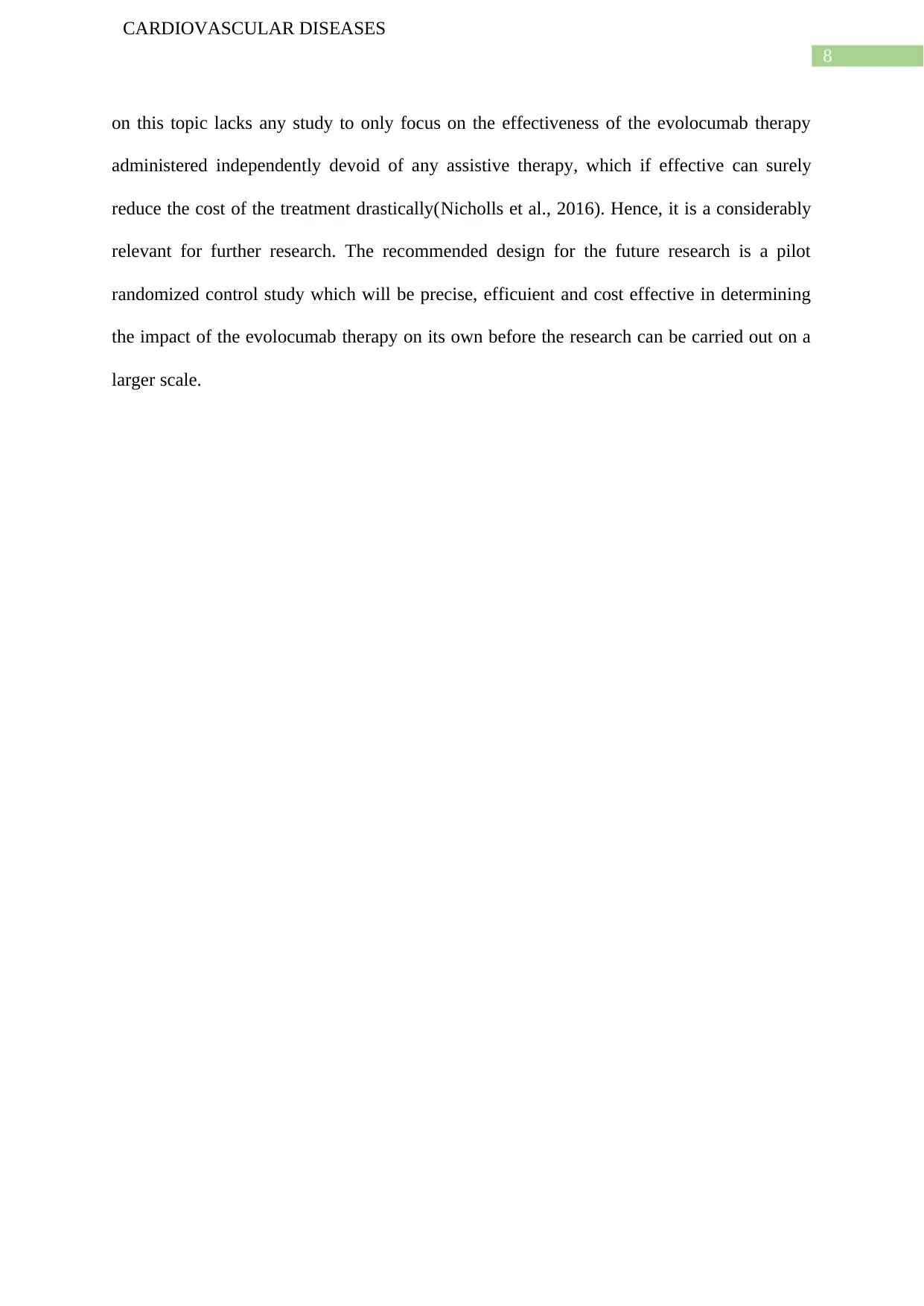
8
CARDIOVASCULAR DISEASES
on this topic lacks any study to only focus on the effectiveness of the evolocumab therapy
administered independently devoid of any assistive therapy, which if effective can surely
reduce the cost of the treatment drastically(Nicholls et al., 2016). Hence, it is a considerably
relevant for further research. The recommended design for the future research is a pilot
randomized control study which will be precise, efficuient and cost effective in determining
the impact of the evolocumab therapy on its own before the research can be carried out on a
larger scale.
CARDIOVASCULAR DISEASES
on this topic lacks any study to only focus on the effectiveness of the evolocumab therapy
administered independently devoid of any assistive therapy, which if effective can surely
reduce the cost of the treatment drastically(Nicholls et al., 2016). Hence, it is a considerably
relevant for further research. The recommended design for the future research is a pilot
randomized control study which will be precise, efficuient and cost effective in determining
the impact of the evolocumab therapy on its own before the research can be carried out on a
larger scale.
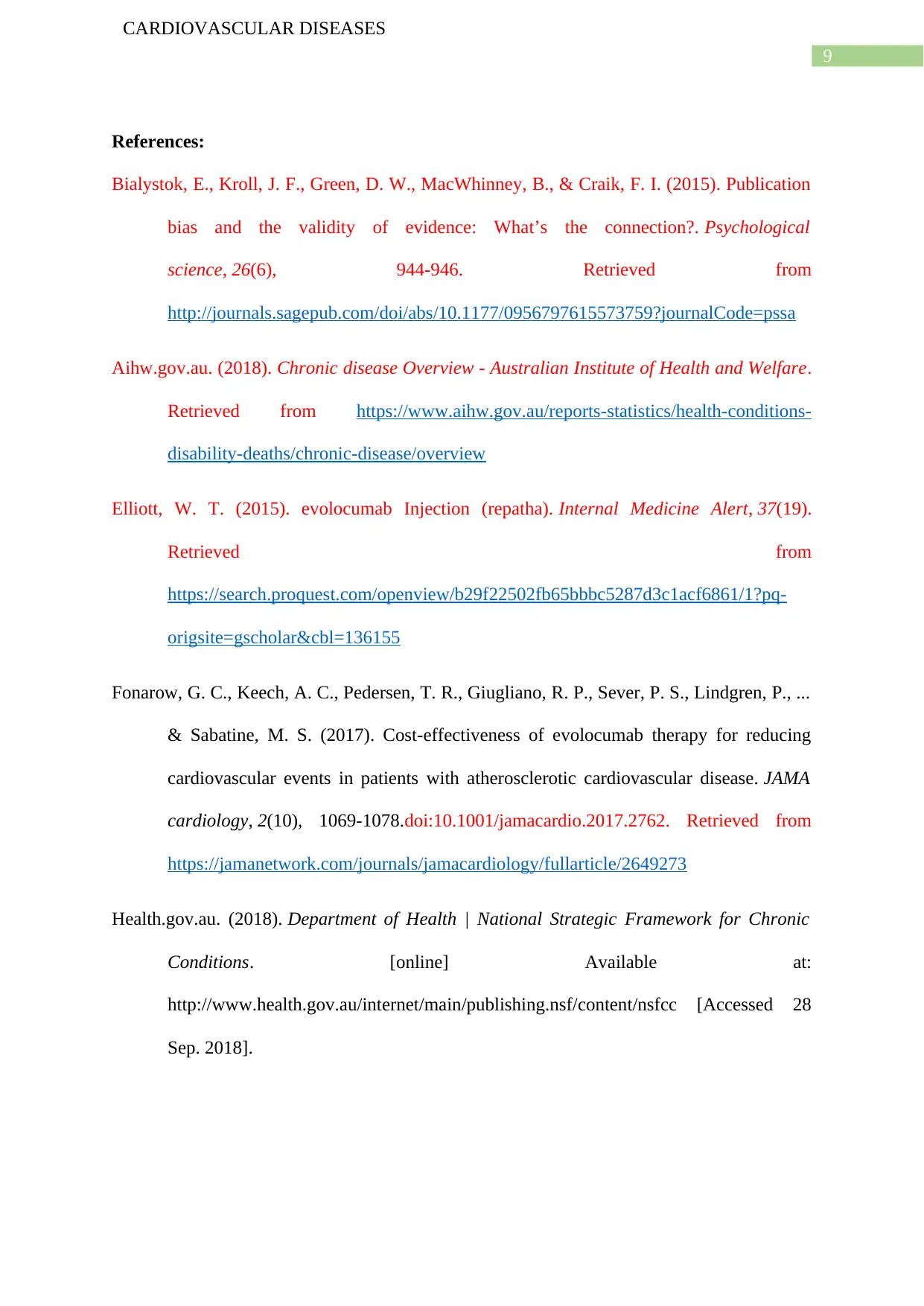
9
CARDIOVASCULAR DISEASES
References:
Bialystok, E., Kroll, J. F., Green, D. W., MacWhinney, B., & Craik, F. I. (2015). Publication
bias and the validity of evidence: What’s the connection?. Psychological
science, 26(6), 944-946. Retrieved from
http://journals.sagepub.com/doi/abs/10.1177/0956797615573759?journalCode=pssa
Aihw.gov.au. (2018). Chronic disease Overview - Australian Institute of Health and Welfare.
Retrieved from https://www.aihw.gov.au/reports-statistics/health-conditions-
disability-deaths/chronic-disease/overview
Elliott, W. T. (2015). evolocumab Injection (repatha). Internal Medicine Alert, 37(19).
Retrieved from
https://search.proquest.com/openview/b29f22502fb65bbbc5287d3c1acf6861/1?pq-
origsite=gscholar&cbl=136155
Fonarow, G. C., Keech, A. C., Pedersen, T. R., Giugliano, R. P., Sever, P. S., Lindgren, P., ...
& Sabatine, M. S. (2017). Cost-effectiveness of evolocumab therapy for reducing
cardiovascular events in patients with atherosclerotic cardiovascular disease. JAMA
cardiology, 2(10), 1069-1078.doi:10.1001/jamacardio.2017.2762. Retrieved from
https://jamanetwork.com/journals/jamacardiology/fullarticle/2649273
Health.gov.au. (2018). Department of Health | National Strategic Framework for Chronic
Conditions. [online] Available at:
http://www.health.gov.au/internet/main/publishing.nsf/content/nsfcc [Accessed 28
Sep. 2018].
CARDIOVASCULAR DISEASES
References:
Bialystok, E., Kroll, J. F., Green, D. W., MacWhinney, B., & Craik, F. I. (2015). Publication
bias and the validity of evidence: What’s the connection?. Psychological
science, 26(6), 944-946. Retrieved from
http://journals.sagepub.com/doi/abs/10.1177/0956797615573759?journalCode=pssa
Aihw.gov.au. (2018). Chronic disease Overview - Australian Institute of Health and Welfare.
Retrieved from https://www.aihw.gov.au/reports-statistics/health-conditions-
disability-deaths/chronic-disease/overview
Elliott, W. T. (2015). evolocumab Injection (repatha). Internal Medicine Alert, 37(19).
Retrieved from
https://search.proquest.com/openview/b29f22502fb65bbbc5287d3c1acf6861/1?pq-
origsite=gscholar&cbl=136155
Fonarow, G. C., Keech, A. C., Pedersen, T. R., Giugliano, R. P., Sever, P. S., Lindgren, P., ...
& Sabatine, M. S. (2017). Cost-effectiveness of evolocumab therapy for reducing
cardiovascular events in patients with atherosclerotic cardiovascular disease. JAMA
cardiology, 2(10), 1069-1078.doi:10.1001/jamacardio.2017.2762. Retrieved from
https://jamanetwork.com/journals/jamacardiology/fullarticle/2649273
Health.gov.au. (2018). Department of Health | National Strategic Framework for Chronic
Conditions. [online] Available at:
http://www.health.gov.au/internet/main/publishing.nsf/content/nsfcc [Accessed 28
Sep. 2018].
⊘ This is a preview!⊘
Do you want full access?
Subscribe today to unlock all pages.

Trusted by 1+ million students worldwide
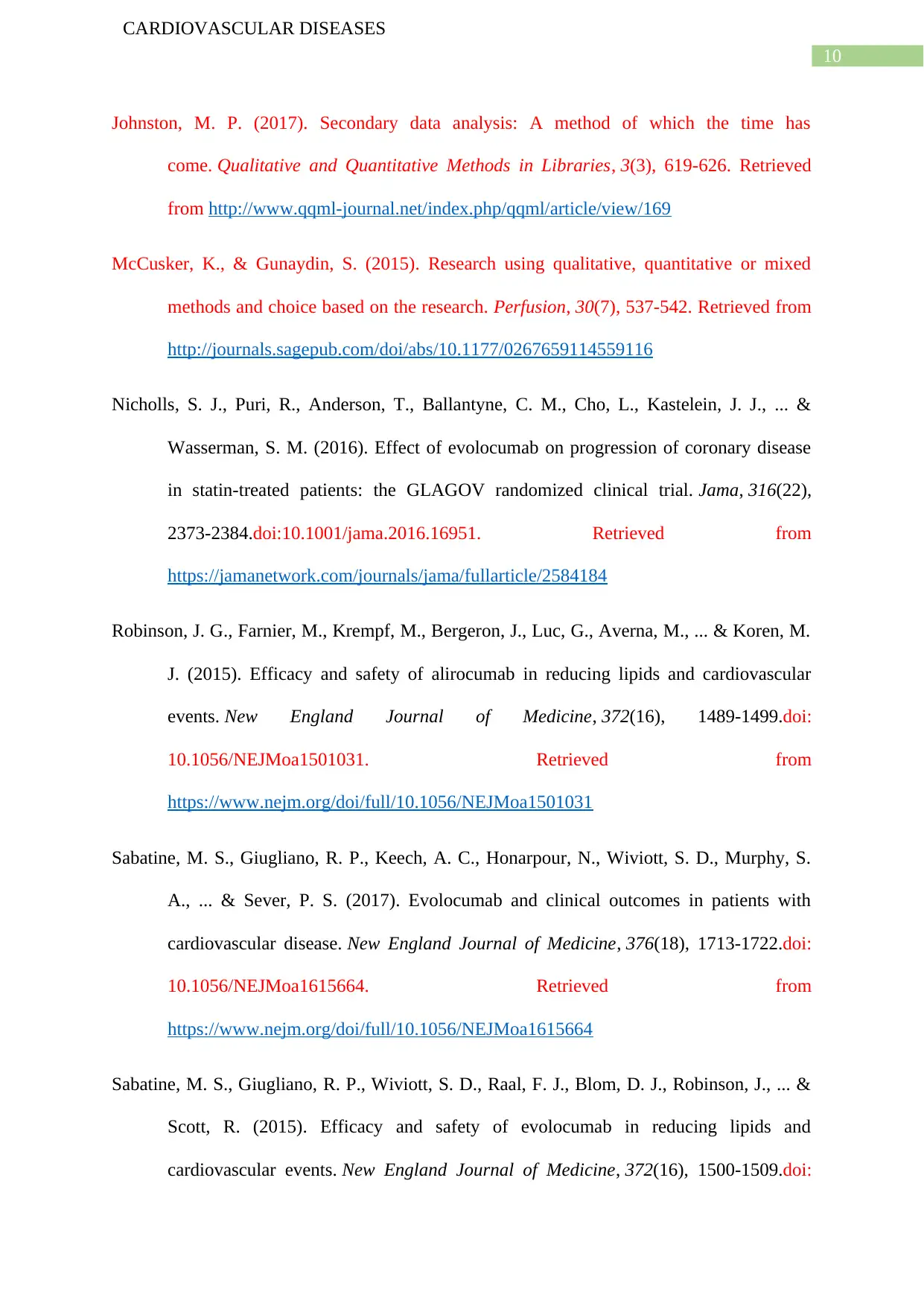
10
CARDIOVASCULAR DISEASES
Johnston, M. P. (2017). Secondary data analysis: A method of which the time has
come. Qualitative and Quantitative Methods in Libraries, 3(3), 619-626. Retrieved
from http://www.qqml-journal.net/index.php/qqml/article/view/169
McCusker, K., & Gunaydin, S. (2015). Research using qualitative, quantitative or mixed
methods and choice based on the research. Perfusion, 30(7), 537-542. Retrieved from
http://journals.sagepub.com/doi/abs/10.1177/0267659114559116
Nicholls, S. J., Puri, R., Anderson, T., Ballantyne, C. M., Cho, L., Kastelein, J. J., ... &
Wasserman, S. M. (2016). Effect of evolocumab on progression of coronary disease
in statin-treated patients: the GLAGOV randomized clinical trial. Jama, 316(22),
2373-2384.doi:10.1001/jama.2016.16951. Retrieved from
https://jamanetwork.com/journals/jama/fullarticle/2584184
Robinson, J. G., Farnier, M., Krempf, M., Bergeron, J., Luc, G., Averna, M., ... & Koren, M.
J. (2015). Efficacy and safety of alirocumab in reducing lipids and cardiovascular
events. New England Journal of Medicine, 372(16), 1489-1499.doi:
10.1056/NEJMoa1501031. Retrieved from
https://www.nejm.org/doi/full/10.1056/NEJMoa1501031
Sabatine, M. S., Giugliano, R. P., Keech, A. C., Honarpour, N., Wiviott, S. D., Murphy, S.
A., ... & Sever, P. S. (2017). Evolocumab and clinical outcomes in patients with
cardiovascular disease. New England Journal of Medicine, 376(18), 1713-1722.doi:
10.1056/NEJMoa1615664. Retrieved from
https://www.nejm.org/doi/full/10.1056/NEJMoa1615664
Sabatine, M. S., Giugliano, R. P., Wiviott, S. D., Raal, F. J., Blom, D. J., Robinson, J., ... &
Scott, R. (2015). Efficacy and safety of evolocumab in reducing lipids and
cardiovascular events. New England Journal of Medicine, 372(16), 1500-1509.doi:
CARDIOVASCULAR DISEASES
Johnston, M. P. (2017). Secondary data analysis: A method of which the time has
come. Qualitative and Quantitative Methods in Libraries, 3(3), 619-626. Retrieved
from http://www.qqml-journal.net/index.php/qqml/article/view/169
McCusker, K., & Gunaydin, S. (2015). Research using qualitative, quantitative or mixed
methods and choice based on the research. Perfusion, 30(7), 537-542. Retrieved from
http://journals.sagepub.com/doi/abs/10.1177/0267659114559116
Nicholls, S. J., Puri, R., Anderson, T., Ballantyne, C. M., Cho, L., Kastelein, J. J., ... &
Wasserman, S. M. (2016). Effect of evolocumab on progression of coronary disease
in statin-treated patients: the GLAGOV randomized clinical trial. Jama, 316(22),
2373-2384.doi:10.1001/jama.2016.16951. Retrieved from
https://jamanetwork.com/journals/jama/fullarticle/2584184
Robinson, J. G., Farnier, M., Krempf, M., Bergeron, J., Luc, G., Averna, M., ... & Koren, M.
J. (2015). Efficacy and safety of alirocumab in reducing lipids and cardiovascular
events. New England Journal of Medicine, 372(16), 1489-1499.doi:
10.1056/NEJMoa1501031. Retrieved from
https://www.nejm.org/doi/full/10.1056/NEJMoa1501031
Sabatine, M. S., Giugliano, R. P., Keech, A. C., Honarpour, N., Wiviott, S. D., Murphy, S.
A., ... & Sever, P. S. (2017). Evolocumab and clinical outcomes in patients with
cardiovascular disease. New England Journal of Medicine, 376(18), 1713-1722.doi:
10.1056/NEJMoa1615664. Retrieved from
https://www.nejm.org/doi/full/10.1056/NEJMoa1615664
Sabatine, M. S., Giugliano, R. P., Wiviott, S. D., Raal, F. J., Blom, D. J., Robinson, J., ... &
Scott, R. (2015). Efficacy and safety of evolocumab in reducing lipids and
cardiovascular events. New England Journal of Medicine, 372(16), 1500-1509.doi:
Paraphrase This Document
Need a fresh take? Get an instant paraphrase of this document with our AI Paraphraser
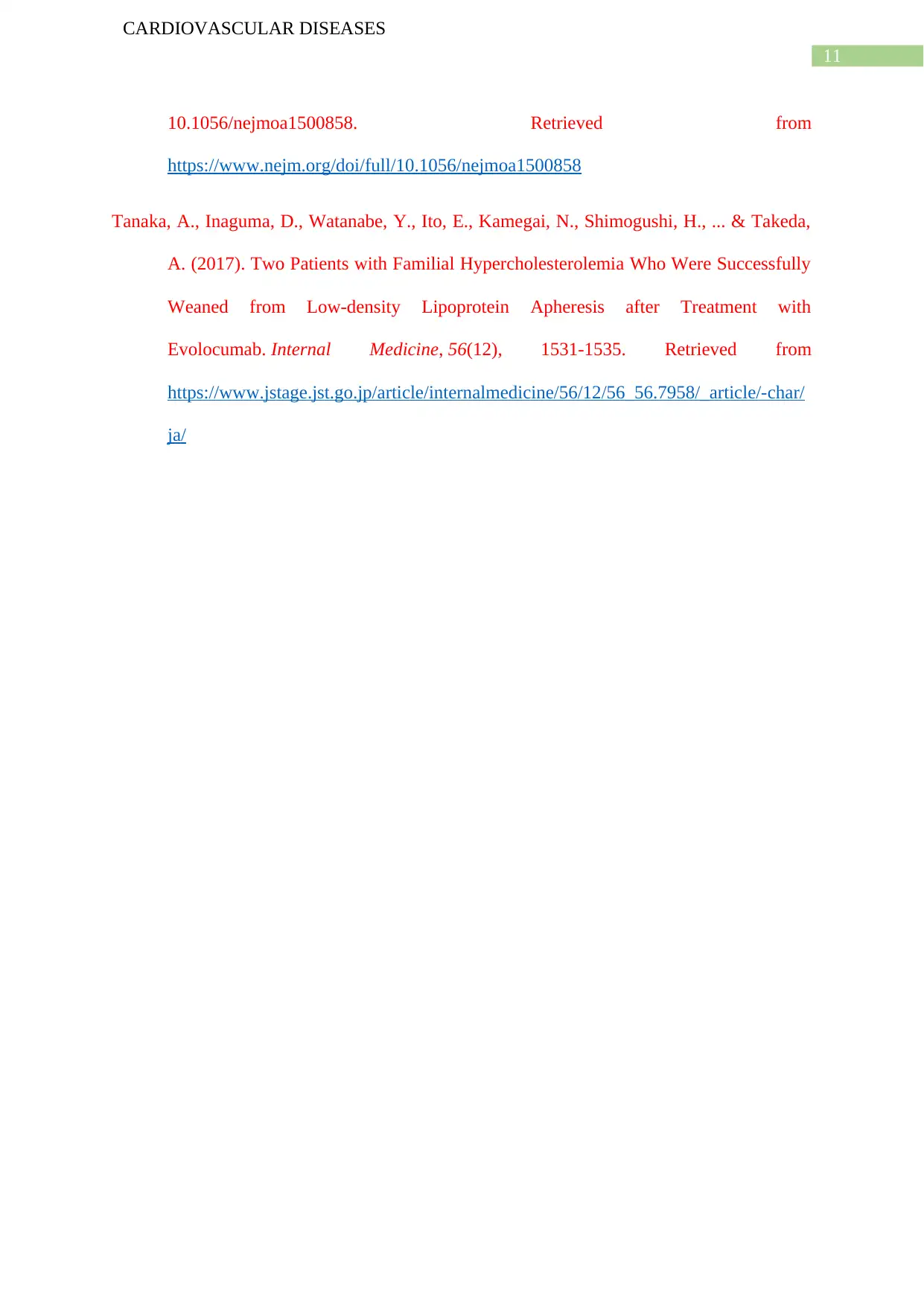
11
CARDIOVASCULAR DISEASES
10.1056/nejmoa1500858. Retrieved from
https://www.nejm.org/doi/full/10.1056/nejmoa1500858
Tanaka, A., Inaguma, D., Watanabe, Y., Ito, E., Kamegai, N., Shimogushi, H., ... & Takeda,
A. (2017). Two Patients with Familial Hypercholesterolemia Who Were Successfully
Weaned from Low-density Lipoprotein Apheresis after Treatment with
Evolocumab. Internal Medicine, 56(12), 1531-1535. Retrieved from
https://www.jstage.jst.go.jp/article/internalmedicine/56/12/56_56.7958/_article/-char/
ja/
CARDIOVASCULAR DISEASES
10.1056/nejmoa1500858. Retrieved from
https://www.nejm.org/doi/full/10.1056/nejmoa1500858
Tanaka, A., Inaguma, D., Watanabe, Y., Ito, E., Kamegai, N., Shimogushi, H., ... & Takeda,
A. (2017). Two Patients with Familial Hypercholesterolemia Who Were Successfully
Weaned from Low-density Lipoprotein Apheresis after Treatment with
Evolocumab. Internal Medicine, 56(12), 1531-1535. Retrieved from
https://www.jstage.jst.go.jp/article/internalmedicine/56/12/56_56.7958/_article/-char/
ja/
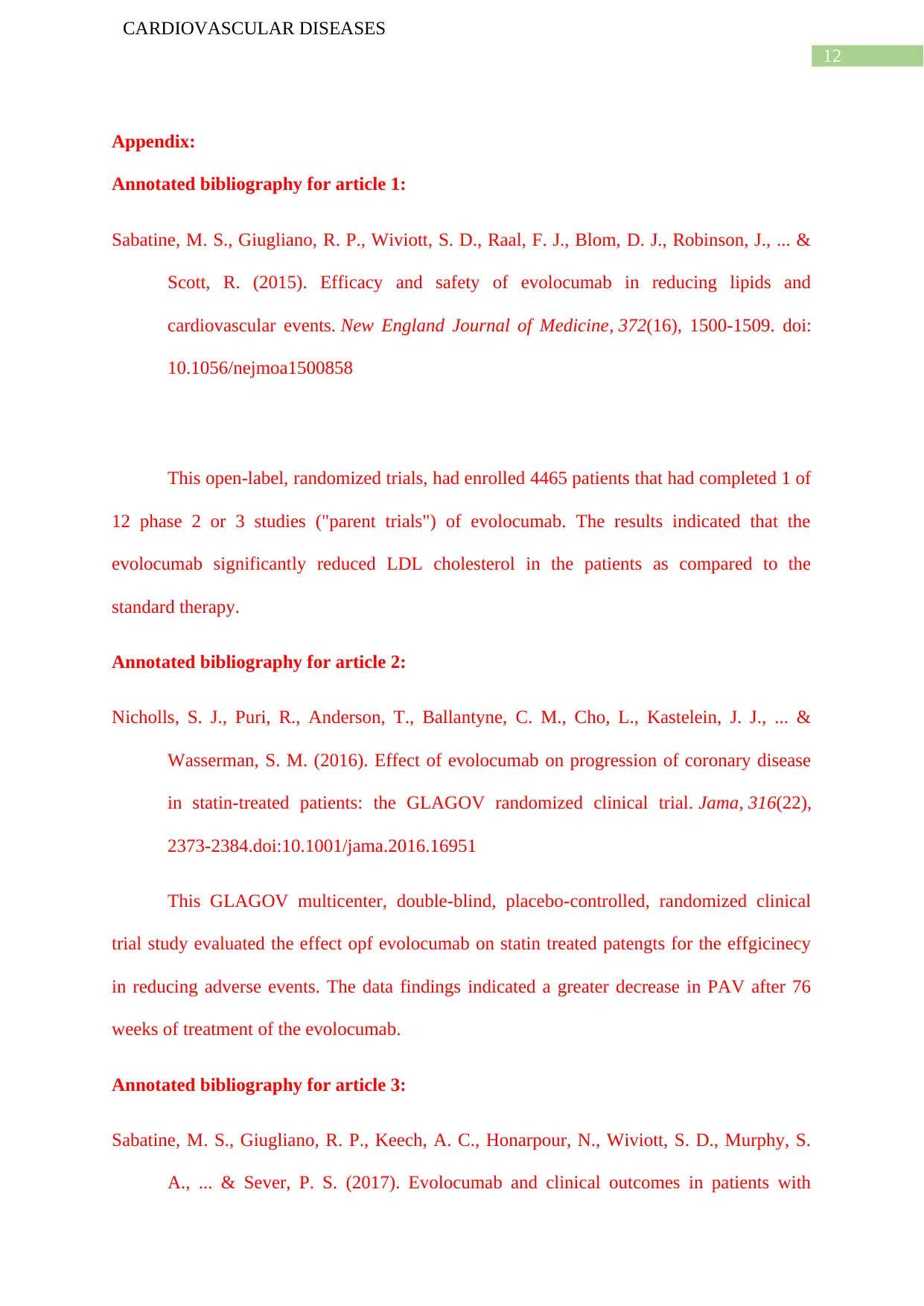
12
CARDIOVASCULAR DISEASES
Appendix:
Annotated bibliography for article 1:
Sabatine, M. S., Giugliano, R. P., Wiviott, S. D., Raal, F. J., Blom, D. J., Robinson, J., ... &
Scott, R. (2015). Efficacy and safety of evolocumab in reducing lipids and
cardiovascular events. New England Journal of Medicine, 372(16), 1500-1509. doi:
10.1056/nejmoa1500858
This open-label, randomized trials, had enrolled 4465 patients that had completed 1 of
12 phase 2 or 3 studies ("parent trials") of evolocumab. The results indicated that the
evolocumab significantly reduced LDL cholesterol in the patients as compared to the
standard therapy.
Annotated bibliography for article 2:
Nicholls, S. J., Puri, R., Anderson, T., Ballantyne, C. M., Cho, L., Kastelein, J. J., ... &
Wasserman, S. M. (2016). Effect of evolocumab on progression of coronary disease
in statin-treated patients: the GLAGOV randomized clinical trial. Jama, 316(22),
2373-2384.doi:10.1001/jama.2016.16951
This GLAGOV multicenter, double-blind, placebo-controlled, randomized clinical
trial study evaluated the effect opf evolocumab on statin treated patengts for the effgicinecy
in reducing adverse events. The data findings indicated a greater decrease in PAV after 76
weeks of treatment of the evolocumab.
Annotated bibliography for article 3:
Sabatine, M. S., Giugliano, R. P., Keech, A. C., Honarpour, N., Wiviott, S. D., Murphy, S.
A., ... & Sever, P. S. (2017). Evolocumab and clinical outcomes in patients with
CARDIOVASCULAR DISEASES
Appendix:
Annotated bibliography for article 1:
Sabatine, M. S., Giugliano, R. P., Wiviott, S. D., Raal, F. J., Blom, D. J., Robinson, J., ... &
Scott, R. (2015). Efficacy and safety of evolocumab in reducing lipids and
cardiovascular events. New England Journal of Medicine, 372(16), 1500-1509. doi:
10.1056/nejmoa1500858
This open-label, randomized trials, had enrolled 4465 patients that had completed 1 of
12 phase 2 or 3 studies ("parent trials") of evolocumab. The results indicated that the
evolocumab significantly reduced LDL cholesterol in the patients as compared to the
standard therapy.
Annotated bibliography for article 2:
Nicholls, S. J., Puri, R., Anderson, T., Ballantyne, C. M., Cho, L., Kastelein, J. J., ... &
Wasserman, S. M. (2016). Effect of evolocumab on progression of coronary disease
in statin-treated patients: the GLAGOV randomized clinical trial. Jama, 316(22),
2373-2384.doi:10.1001/jama.2016.16951
This GLAGOV multicenter, double-blind, placebo-controlled, randomized clinical
trial study evaluated the effect opf evolocumab on statin treated patengts for the effgicinecy
in reducing adverse events. The data findings indicated a greater decrease in PAV after 76
weeks of treatment of the evolocumab.
Annotated bibliography for article 3:
Sabatine, M. S., Giugliano, R. P., Keech, A. C., Honarpour, N., Wiviott, S. D., Murphy, S.
A., ... & Sever, P. S. (2017). Evolocumab and clinical outcomes in patients with
⊘ This is a preview!⊘
Do you want full access?
Subscribe today to unlock all pages.

Trusted by 1+ million students worldwide
1 out of 13
Your All-in-One AI-Powered Toolkit for Academic Success.
+13062052269
info@desklib.com
Available 24*7 on WhatsApp / Email
![[object Object]](/_next/static/media/star-bottom.7253800d.svg)
Unlock your academic potential
Copyright © 2020–2025 A2Z Services. All Rights Reserved. Developed and managed by ZUCOL.
